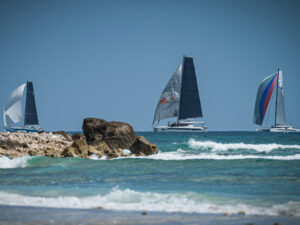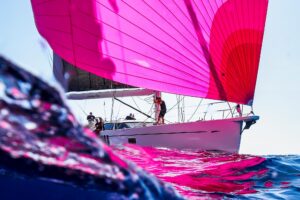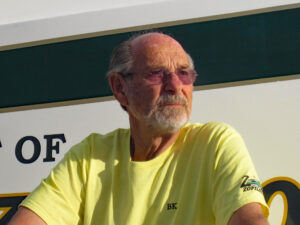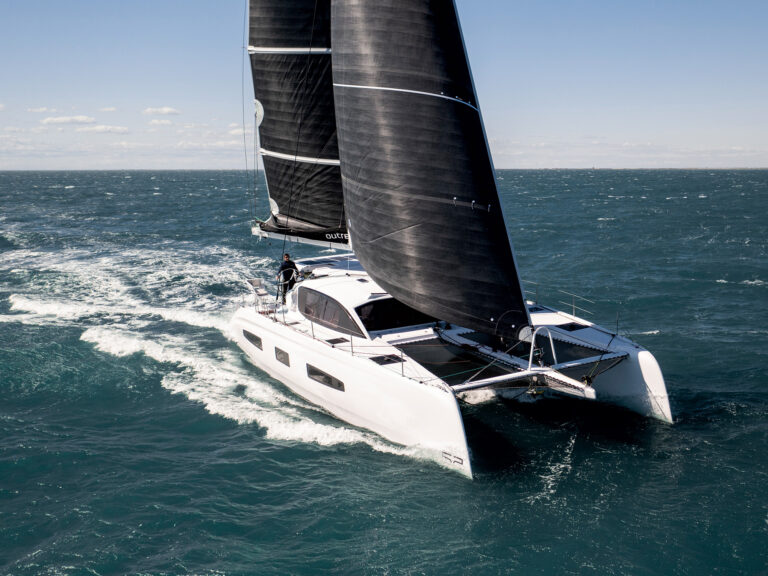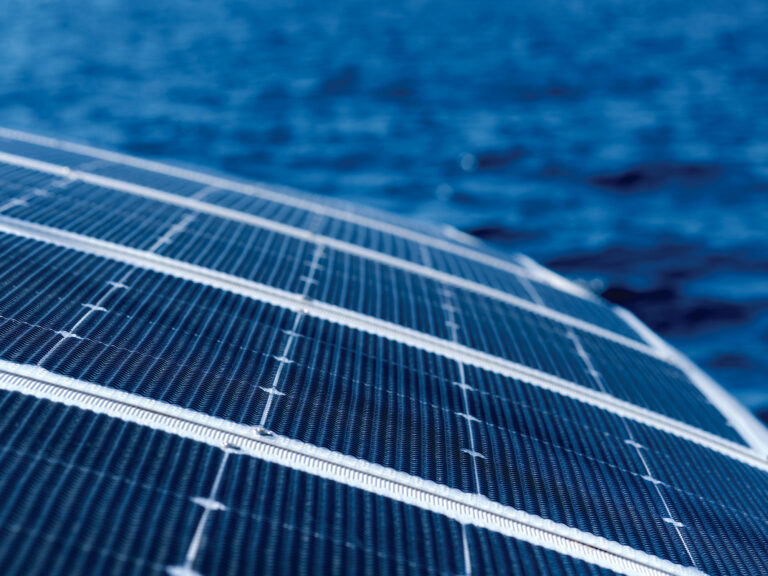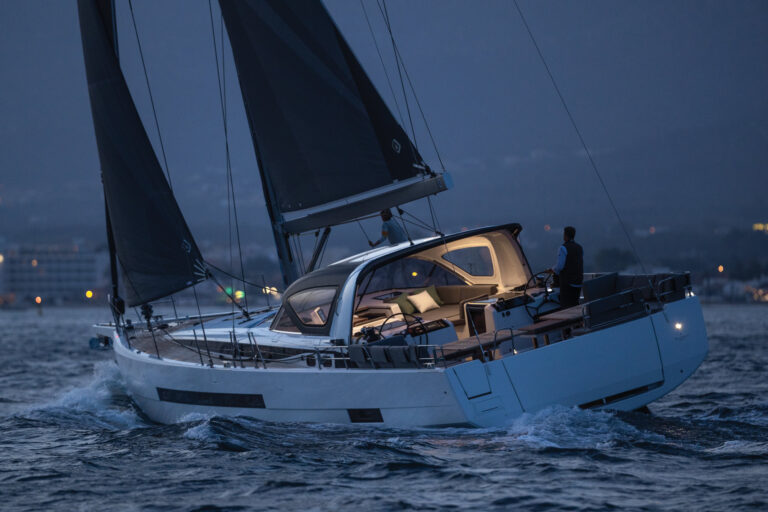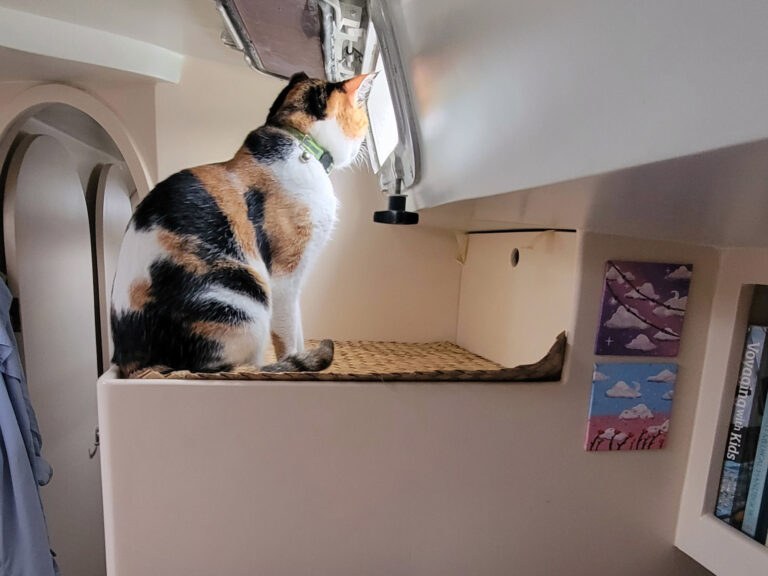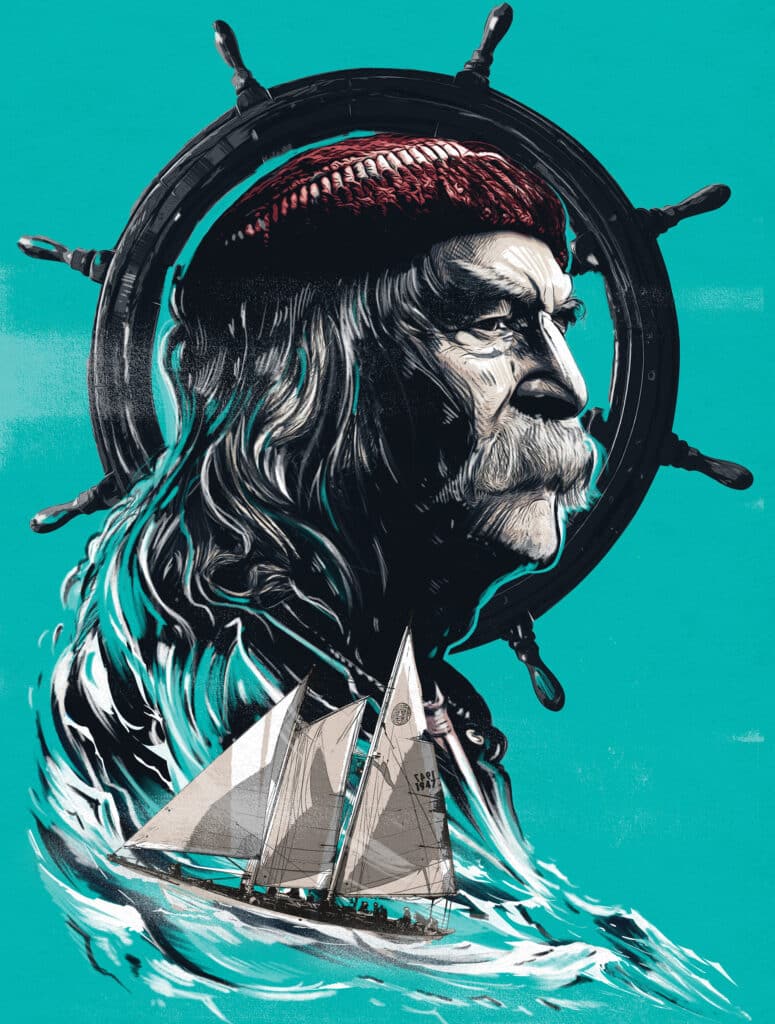
Many, many months after rock star David Crosby struck a deal to sell his classic schooner to Beau and Stacey Vrolyk, the deal was instead stuck, dead in the water. But that’s not where this story ends—or begins. Two stories, really.
John Alden design No. 356B launched in 1947 in British Honduras, land of the Mayas, and the 59-foot schooner Mayan is a celebrity today wherever she goes. Pampered inch by inch and pound for pound, all 70,000 pounds, Mayan is home-ported in San Francisco Bay as the flagship of St. Francis Yacht Club. Under 2023 Commodore Beau Vrolyk, there is gravitas in that. How it came to be, after those many, many perplexing months of waiting to buy, is one story.
Mayan, however, had already touched the hearts of millions—millions who might not know the boat beyond their imaginings of a song about “wooden ships, on the water, very free and easy.” A reader might recognize the words and phrasing of the troubadour who owned Mayan for 45 years, from 1969 to 2014. If something made to go places can be said to be an anchor, Mayan was that, the emotional anchor in Crosby’s rich but tumultuous life.
When Crosby bought Mayan out of the charter trade in 1969, he was riding the height of fame. His earliest musical hits with the Byrds had included a cover of Bob Dylan’s “Tambourine Man” that defined folk rock. Later came the Byrds’ own (ahem) “Eight Miles High.”Now, the eponymous debut album of Crosby, Stills & Nash was shooting straight to the top, and the three were honored as best new artists at the 1969 Grammy Awards. It was a heady time. Woodstock lay on the horizon. The political landscape was ablaze. And along with the discovery that he could harmonize with Stephen Stills and Graham Nash to create a unique sound came a preference to think of the group not as a band, but as individuals. They would be together or not, harmonizing or not and feuding or not, for the rest of their personal and professional lives.
It was in a period of feuding and drifting that Crosby spotted Mayan for sale in Port Everglades, Florida. Think of it as one of the great love-at-first-sight sagas of his generation. A loan from Peter Tork of The Monkees—flush with TV money—closed the purchase, and Crosby called it “the best money I ever spent.” By and by, he cruised the boatfrom Florida through the Caribbean, through the Panama Canal, and up the coast of the Americas to the Golden Gate Bridge, where Mayan became a fixture on San Francisco Bay.
Arriving in the early 1970s, Crosby docked Mayan at a new home in downtown Sausalito, a long walk out Pier 2, which might as well have had a red carpet for all the names-you-know who made the walk. To pick just one, Joni Mitchell was inspired to sing, writing herself into the story: “There’s a man who’s been out sailing, in a decade full of dreams, and he takes her to a schooner, and he treats her like a queen.”
Sausalito was turning from a quaint, bohemian village with a Riviera vibe into a tourist town with a view of San Francisco, but it had a pulse. The hills were rockin’, and there was still a five-and-dime on the main drag a stone’s throw from the scene-makers’ scene, a waterfront restaurant called the Trident. Rock impresario Bill Graham chose the Trident to host the Rolling Stones, more than once. Janis Joplin had her own table. And an outbound, starboard-tack flyby and a wave to the Trident might cover Crosby’s launch of any bay cruise aboard Mayan. Plant a stake in the mandala for that brief moment in time. Crosby asked in a song in 1974: “Will our love beat on (after we are gone)? Traveling beyond (what do we become?).”
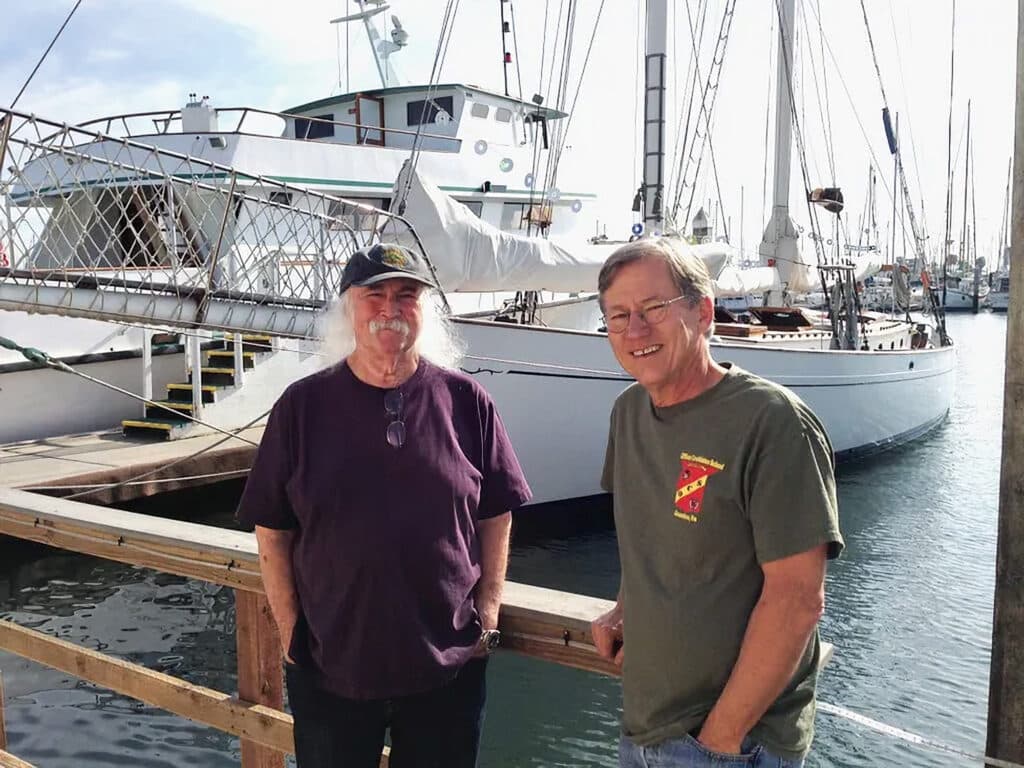
The five-and-dime disappeared as the tourist shops moved in. For Crosby, the hits kept coming through breakups, reunions and solo albums. And the sea beckoned. As the years went by, Mayan carried Crosby and friends beyond San Francisco Bay to the far reaches of the South Pacific, into its rainbow of colors not otherwise known to nature. The air is soft there. The water is warm. Crosby was an avid diver, and Mayan’s shallow draft of 4 feet, 5 inches with the centerboard served up perfectly. An air-tank rack was built into the cabin to keep the action going, and the skipper once said that he “could just jump off and dive on some of the most beautiful reefs in the world.”
Much of the reflection that followed the singer’s death in January 2023 recalled his high-handed difficulties with fellow musicians or his descent in the 1980s into addictions and legal trauma. At one point, with the law on his mustachioed, long-haired trail, he imagined all would be well if he could just get to that saloon where songs had been born and sung, where he would be wrapped in the arms of Mother Mayan. That delusion was soon punctured, and there are more twists to the Crosby story: eventually thanking a judge for sentencing him to the harsh confines of a Texas prison because he came out clean and sober—with a future. Giving up the boat. Getting it back.
Crosby’s delusional episodes intersect our stories where we began, with the sale of the boat up in the air and the frustrated would-be buyers, Beau and Stacey, wondering what in blazes was going on so many months after the owner had promised to sign.
They found the answer, but first, here is Beau Vrolyk’s description of Crosby as a sailor’s sailor, respected dockside in every harbor he visited: “David was a careful sailor, in the true meaning of that word. He cared for Mayan and her crew. He knew his ship, and made sure she and all she carried were safe. His love of Mayan showed in how he handled her at sea. There was none of the irascible rock star showing when we talked of sailing, just the normal swapping of sea stories.”
Stacey was reading David [Crosby]’s book Long Time Gone, and it dawned on her that he wasn’t selling a boat. He was letting go of a piece of himself.
That’s the man they were dealing with, a gem except for his quirky refusal to close the sale. To address that, we need to start our story again, around 2012, with the Vrolyks realizing that their lovely, lively Spirit 46, innocent of lifelines, was not a playground for the grandkids. Vrolyk is himself a sailor’s sailor, starting as a kid at the Los Angeles Yacht Club, covering serious miles on the family’s 23-foot gaff-rigged cruiser. He continued through a career in software and investing, with a lot of sailing and voyaging in the mix. In his college years, on weekends, he skippered the celebrated schooner Salee. “That is where I fell in love with Alden schooners,” he says, and with that passion, he sold the notion to Stacey as she moved into the sailing life from a career in marketing for multibillion-dollar companies. Thus began their collaboration and an international search.
“We looked at 12 schooners in all, in the US and Europe,” Vrolyk says. “I was even willing to consider a Starling Burgess, but Burgess put on too much sail. A schooner like Niña, for example, was a history-making race boat but never intended for cruising. Eventually, I made an offer on a boat in San Diego, and I called up an old friend who also grew up at LAYC, Stan Honey. He told me, ‘Don’t buy anything until Wayne Ettel has a look at it.’”
Well-regarded for restorations at Boatswayne, his Wilmington, California, boatworks, and always keen to credit his start in the Sea Scouts, Ettel studied the prospective purchase on the hard at San Diego’s Shelter Island. He quickly dismissed the schooner in question. Then he suggested lunch down the street at the Red Sails Inn to consider the background and experience of the purchaser, and the intended use. The answer: coastal cruising and perhaps a foray into the Pacific. With that on the table, Ettel declared, “Mayan is the boat you need.”
As Vrolyk recalls: “We had been aware of Mayan, but the asking price was outrageous. Wayne said to ignore that because Crosby doesn’t want to sell, but he needs to sell, and he won’t sell to just anybody. Write a half-page letter with a résumé attached, and tell David what you intend to do with the boat. He gave me a number that he said was a fair price to offer. I sent it off in the mail, and two days later, the phone rang. It was David telling me to come to Santa Barbara: ‘We’ll eat tacos and talk about the boat.’ So, I drove down from the Bay Area, and we ordered tacos at a hole-in-the-wall, and then spent three hours going over the boat.”
Vrolyk says he realized later that Crosby had been studying every move he made, to see if he was the real deal. “Then, standing in the parking lot, I asked, ‘Where do we go from here?’” Vrolyk says. “David said, ‘We shake hands, and I sell you the boat.’ It was that simple. I called Stacey on the drive home to tell her, ‘I think we just bought a boat.’”
Ettel could speak with confidence because he had gone deep on Mayan only a few years earlier. As Vrolyk tells it: “David had poured money into the boat. Ettel had taken off every plank and replaced 90 percent of the frames with purpleheart. He put in stainless-steel floor frames to replace the cast-iron originals, and double-planked the hull with sapele and cedar. Oh, and the planks were set in epoxy and fastened with bronze screws instead of the original galvanized nails. The people who used to build boats like this projected a life expectancy of 15 to 20 years. Wayne made this one pretty much bomb-proof.”
Add another trip to Santa Barbara with brokers and paperwork, and, Vrolyk says: “I signed the purchase papers. David said he would sign that night.”
But Crosby didn’t sign.
And there they were, many months along, a pair of frustrated, perplexed buyers but with a fresh insight. As Vrolyk recalls: “Stacey was reading David’s book Long Time Gone, and it dawned on her that he wasn’t selling a boat. He was letting go of a piece of himself.” When Vrolyk pressed his case again: “David burst into tears on the phone and told me he had promised his youngest son, Django, that they would sail together to Hawaii someday. If he sold, that day would never come: ‘What do I tell my kid?’
“‘Bring Django, and we’ll sail to Hawaii together,’ I said. ‘You’ll be the skipper. I’ll crew. And every time, and I mean every time, Mayan goes anywhere more than a daysail, I’ll let you know a week ahead, and you can come with us.’
“‘You would do that for me?’
“I said, ‘Give me a break! Who wouldn’t want to go sailing with David Crosby?’ He cracked up.”
So the boat changed hands, and Vrolyk set to work fulfilling his vision of the ultimate Mayan. He is a hands-on owner, but a boat 60 feet on deck is too much for any one person, and the transformation was gradual. The skipper was inspired, one step leading to the next, to return the boat from staysail schooner to its original rig as drawn by Alden. That meant a transitional schooner with the traditional gaff foresail and a Marconi main. In the 1930s, that hybrid setup had become a popular means to reduce crew numbers, and by then, Marconi mains had proved fast to weather.
Alden liked gaff foresails for their efficiency on a reach. The crew could pull the gaff to windward with a vang led to the mainmast without overtightening the leach. Also, a gaff forward is much smaller than a gaff on the main, making it easier for smaller crews to manage.
Eventually, however, and following a different trend, Mayan’s forward gaff had been removed in favor of a more manageable main staysail. That is how Crosby sailed it, and that is how Vrolyk found the boat. By midcentury, staysail schooners were fashionable, pegged to the 1928 staysail schooner Niña and her trans-Atlantic and Fastnet Race wins. Having thus simplified things, racing crew quickly turned to complicating the schooners again with topmast staysails to fly above the main staysail. Now we add names such as Little Fisherman, Fisherman, Advance and—everybody’s favorite—the Gollywobbler. Vrolyk says, “There’s definitely a ring to shouting, ‘Hoist the Gollywobbler!’”
But as he piled up miles and got into classics racing (“David thought I was nuts; he never raced”), Vrolyk became disillusioned with the topmast staysails that he had inherited. In the process, he was backed by the likes of Stan Honey and, as frequent crew, a man who helped revolutionize downwind racing, naval architect Bill Lee.
“We were blessed with a cadre of professional minds who wanted to sail on the boat, and we began the process of shrinking sail inventory when Bill Lee observed that, once you get to hull speed, more sail doesn’t help,” Vrolyk says. “Among Bill’s designs was the quintessential downwind flyer for Transpac, Merlin, and nothing could be more different from a 70,000-pound schooner, but Bill’s an engineer through and through. He enjoyed the challenge of making an old boat faster. It was a game to him.”
And so, Mayan today is back to her original configuration as a transitional schooner, gaff fore and Marconi main. And Mayan wins races. More important, the Vrolyks can doublehand because the individual sails are manageable.
“The main is about the size of a main on a modern 40-footer,” Vrolyk says, “and there are lots of lines and sails for our grandchildren and guests to call their own.”
Add multiple changes to the arrangement belowdecks: Crosby had a sultan-size bed in the salon—or perhaps we call it a rock-star bed, certainly not a bunk. That is now history, and the head and shower were repositioned. Below the waterline, Mayan got a new rudder shape that balanced a once-heavy helm. Meanwhile, a thick book’s worth of fine woodworking went into bringing the deck and house to Bristol presentation, along with new sails and new lines. Now it’s “just” a matter of maintaining a wood boat, rather in the way that a plane in the sky must keep moving or else.
True to his word, Vrolyk invited Crosby sailing many times, “but he was always on tour or in the studio.” It went on, and it went on. “David always responded quickly, but it was always no. Eventually I said, ‘Sheesh, just come sit on the boat.’”
A beat.
“That’s when David finally told me, ‘I can’t. I like what you’re doing with the boat, but I just can’t do it. It wouldn’t be the same.’”
Decades before, the same voice had sung: “If you don’t like the story or end, well then pick up your pen, and then write it again.”
It wouldn’t be the same. It wouldn’t be the same.

